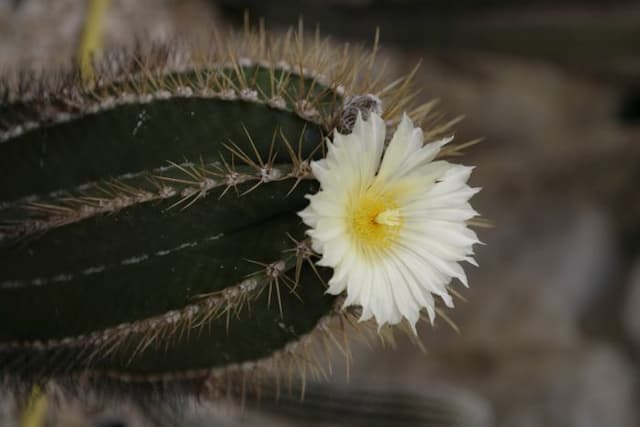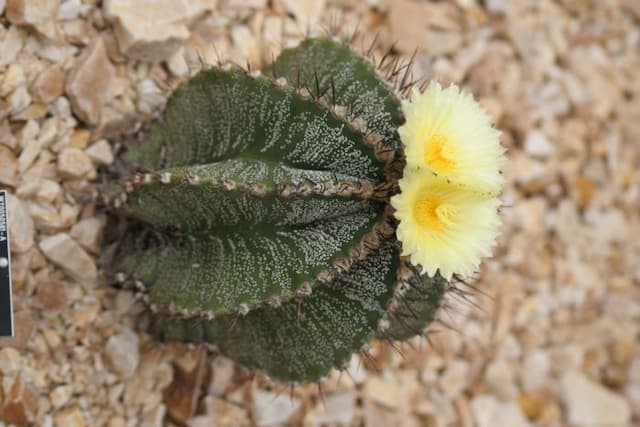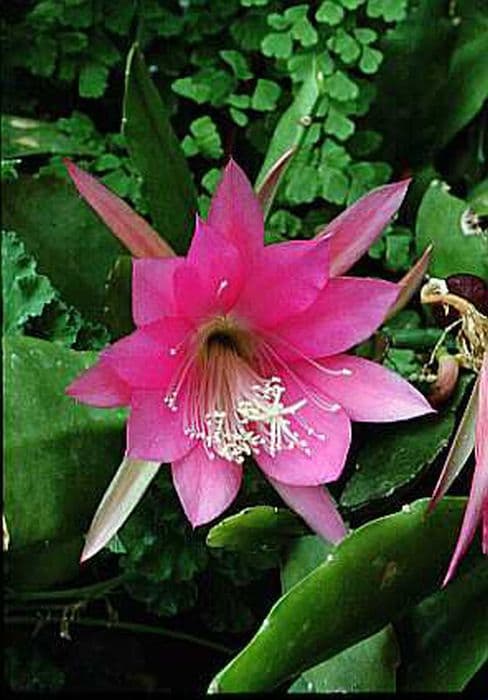Feather Cactus Mammillaria plumosa

ABOUT
The feather cactus is a unique and attractive small plant notable for its soft, feathery spines which give it an almost fuzzy appearance. Its body is made up of small, chunky, globular shapes that cluster together in a dense mound. Each globe – or tubercle – is covered with a mass of interlacing white spines. These spines are so fine and dense that they resemble a tuft of soft down or feathers, which is how this cactus gets its common name. The color of the body is a soft green, which sometimes can be almost hidden beneath the fluffy white spines. This creates a stark, beautiful contrast that draws attention and makes the feather cactus a prized variety for plant enthusiasts. When this cactus blooms, it produces small yellow or pink flowers that add a splash of brightness and beauty to its appearance. These blossoms typically form a ring around the upper part of the globular bodies, presenting a striking halo effect.
About this plant
 Names
NamesFamily
Cactaceae.
Synonyms
Feather Cactus, Feather Ball, Feather Mammillaria.
Common names
Mammillaria plumosa.
 Toxicity
ToxicityTo humans
The Feather Cactus (Mammillaria plumosa) is not known to be toxic to humans. Therefore, there are no typical symptoms of poisoning associated with this plant. However, it is always advisable to avoid ingesting plants that are not commonly used for consumption to prevent any potential adverse reactions.
To pets
The Feather Cactus (Mammillaria plumosa) is also not known to be toxic to pets. Similar to humans, ingestion of non-food plants can potentially cause mild stomach upset in pets, but this cactus does not contain specific toxins that would cause poisoning symptoms in animals typically kept as pets.
 Characteristics
CharacteristicsLife cycle
Perennials
Foliage type
Evergreen
Color of leaves
Varies
Flower color
Varies
Height
6 inches (15 cm)
Spread
12 inches (30 cm)
Plant type
Cactus
Hardiness zones
9
Native area
Mexico
Benefits
 General Benefits
General Benefits- Easy to care for: Mammillaria plumosa, commonly known as the Feather Cactus, is a low-maintenance plant, ideal for beginners or those with a busy lifestyle.
- Drought-tolerant: Being a cactus, it requires minimal watering, making it suitable for dry climates and water-conserving gardens.
- Aesthetic appeal: The Feather Cactus has a unique, soft and fluffy appearance, which can add an interesting texture to any collection of houseplants or succulents.
- Compact size: It remains relatively small, which makes it perfect for indoor environments, windowsills, or small outdoor spaces.
- Spineless: Unlike many cacti, the Feather Cactus has soft spines that are not sharp, making it safer around children and pets.
- Propagation: It can easily be propagated from offsets, allowing plant enthusiasts to expand their collection or share with friends without the need to purchase new plants.
 Medical Properties
Medical PropertiesThis plant is not used for medical purposes.
 Air-purifying Qualities
Air-purifying QualitiesThis plant is not specifically known for air purifying qualities.
 Other Uses
Other Uses- Mammillaria plumosa, commonly known as Feather Cactus, is often used in succulent bonsai arrangements to provide a soft, feathery contrast against more rigid plants.
- The Feather Cactus can be utilized in macro photography to capture its unique texture, making it an ideal subject for photographers specializing in plant and nature imagery.
- Due to its compact size, Mammillaria plumosa serves as a perfect desk plant for small workspaces, adding a touch of green without requiring much space.
- The contrast between the Feather Cactus's soft appearance and other cacti's spiky look makes it a valuable educational tool for demonstrating plant diversity in classrooms.
- This plant can be employed as a natural art object, with craftsmen using it to adorn terrariums or as centerpieces in miniature garden displays.
- Creative gift-givers sometimes use the Feather Cactus as a sustainable alternative to cut flowers for a long-lasting present.
- Hobbyists may use Mammillaria plumosa in diorama scenes to create realistic desert landscapes due to its authentic appearance.
- In thematic events or occasions like a 'Wild West' party, the Feather Cactus can be integrated into the decor to enhance the desert ambiance.
- Due to its soft look, the Feather Cactus could be used in relaxation areas like spas, where it contributes to a calming environment.
- Some pet enthusiasts safely include the Feather Cactus in terrariums for desert reptiles, as long as the animals show no interest in eating the plant.
Interesting Facts
 Feng Shui
Feng ShuiThe Feather Cactus is not used in Feng Shui practice.
 Zodiac Sign Compitability
Zodiac Sign CompitabilityThe Feather Cactus is not used in astrology practice.
 Plant Symbolism
Plant Symbolism- Softness: Mammillaria plumosa, commonly known as Feather Cactus, has a soft, feather-like appearance. This contrasts with the more typical harshness of cacti and can symbolize a gentle or soft approach in life or to others.
- Protection: Despite its soft appearance, Feather Cactus is still a cactus, meaning it has spines that protect it. This symbolizes the need for defense and setting boundaries.
- Resilience: As a cactus, Feather Cactus represents resilience and the ability to thrive in challenging conditions, adapting to less-than-ideal environments.
- Water Conservation: Cacti in general symbolize the smart use of resources, particularly water, which ties into themes of conservation and sustainability.
- Endurance: The ability of the Feather Cactus to survive in arid environments symbolizes endurance and the capability to persist through hard times.
 Water
WaterThe Feather Cactus should be watered sparingly as it is prone to rot if overwatered. During the growing season, which is spring and summer, water when the top inch of soil feels dry, roughly every 7 to 10 days, with about 8-12 ounces of water each time. In fall and winter, reduce watering to every 4 to 6 weeks, providing 6-8 ounces to prevent the soil from remaining soggy. Always ensure the pot has good drainage.
 Light
LightThe Feather Cactus favors bright, indirect light and should be placed in an area where it can receive ample light without being exposed to direct midday sun, which can scorch its delicate spines. An east or west-facing window where it gets morning or late afternoon sun is ideal.
 Temperature
TemperatureThe Feather Cactus thrives in average room temperatures between 70°F and 80°F. It can survive minimum temperatures of 50°F, but cold drafts and temperatures below that can harm the plant. Avoid sudden temperature drops and keep the cactus away from cold windows in the winter.
 Pruning
PruningPruning the Feather Cactus is typically not necessary as it maintains its shape naturally. However, if any part of the plant dies or becomes damaged, it's best to prune it away to prevent decay from spreading. The best time for pruning is during the growing season.
 Cleaning
CleaningNot needed
 Soil
SoilFeather Cactus (Mammillaria plumosa) thrives best in a well-draining soil mix consisting of 50% mineral grit such as coarse sand, perlite, or pumice, mixed with 50% standard cactus potting soil. An ideal soil pH for Feather Cactus should be slightly acidic to slightly alkaline, ranging from 6.0 to 7.5.
 Repotting
RepottingFeather Cactus (Mammillaria plumosa) should be repotted every two to three years or when the plant has outgrown its pot. Repotting should be done in the spring or early summer during the cactus's active growing period.
 Humidity & Misting
Humidity & MistingFeather Cactus (Mammillaria plumosa) prefers low to moderate humidity levels, typical of arid environments. The best humidity range for Feather Cactus is between 40% to 60%.
 Suitable locations
Suitable locationsIndoor
Place in bright, indirect light and ensure pot has good drainage.
Outdoor
Position in partial sun, protect from heavy rain and frost.
Hardiness zone
9-11 USDA
 Life cycle
Life cycleThe Feather Cactus, scientifically named Mammillaria plumosa, begins its life cycle as a seed, commonly germinating in warm temperatures with indirect light and minimal moisture. Once sprouted, the seedling grows slowly, developing a rounded body covered with soft, feather-like spines instead of the more common sharp spines found in other cacti. The plant matures over several years, remaining relatively small but producing offsets or "pups" around its base, which can be separated and replanted to propagate new plants. Throughout its life, during spring to summer, the Feather Cactus may produce small, funnel-shaped flowers, typically creamy white or pale yellow, encircling its crown. After flowering, some Mammillaria species can produce small, fleshy fruits that may also contain seeds, completing the reproductive cycle. The Feather Cactus can live for numerous years, often decades, with proper care involving plenty of light, minimal watering, and avoidance of frost conditions.
 Propogation
PropogationPropogation time
Spring-Early Summer
Propogation: The Feather Cactus (Mammillaria plumosa) is commonly propagated through the use of offsets, which are small cacti that the parent plant produces around its base. This process typically takes place during the warmer months, from late spring to early summer, when the plant is actively growing. To propagate with offsets, carefully remove an offset from the parent plant using a clean, sharp knife, and allow the cut to callous for a few days to reduce the risk of infection. Once calloused, plant the offset in a well-draining cactus mix, ensuring the soil is slightly moist. Place the pot in a warm area with bright, indirect light and wait for new growth to indicate that the offset has established roots.









